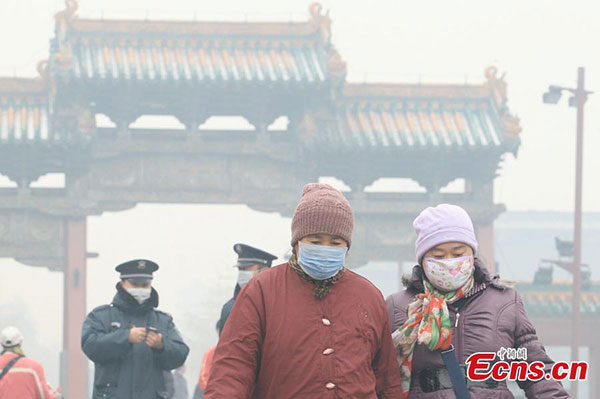
Photo taken on Nov. 8, 2015 shows smog-shrouded downtown Shenyang, northeast China's Liaoning Province. Serious air pollution shrouded 14 cities in Northeast China's Liaoning Province on Sunday, with provincial capital Shenyang witnessing a peak reading of the concentration of PM2.5 - airborne particles measuring less than 2.5 microns in diameter - of 1,017 micrograms per cubic meter. (Photo/CFP)
No letup for five days, watchdog warns as severe pollution spreads rapidly in cities
Thick smog will persist for the next five days in major cities in northeastern China that have seen extremely high air pollution readings since Friday, the national environmental watchdog said on Monday.
Severe pollution has spread rapidly in the three northeastern provinces - Heilongjiang, Jilin and Liaoning.
It affected 10 cities on Friday, 18 on Saturday and 21 on Sunday, Luo Yi, head of the Environmental Monitoring Department under the Ministry of Environmental Protection, said on Monday.
The concentration of PM2.5 - fine particulates that can be hazardous to human health - reached 1,107 micrograms per cubic meter as of 5 pm on Sunday in Shenyang, the capital of Liaoning province, the city's Environmental Protection Bureau said.
The national safety level for PM2.5 is 75 micrograms per cubic meter.
The reading was as high as 1,400 at some monitoring sites in Shenyang. The city government upgraded its emergency response level to the highest tier on Sunday afternoon.
Kong Lin, a 32-year-old Shenyang resident, said, "Although I wore a mask on Sunday, I still had a sore throat and eyes after walking for a while."
The concentration of PM2.5 in Changchun, Jilin, reached 860 micrograms per cubic meter at 8 am on Monday, and another 17 cities in the region also had severe air pollution, the ministry said.
But Chai Fahe, deputy director of the China Research Academy of Environmental Science, said that air quality in Beijing may not deteriorate.
Chai said northerly winds were blowing at times in the area, which were unlikely to bring air pollutants to the capital.
The Shenyang environmental watchdog said coal consumption has soared to provide heating since Nov 1.
Air pollutants carried on the wind from neighboring Jilin and Heilongjiang provinces are the main reason for the extremely high air pollution readings, the watchdog added.
Luo, from the Ministry of Environmental Protection, said a lack of wind made it hard for air pollutants to disperse, and that large emissions from boilers burning coal would mean that smog persists in the northeast until Saturday.
Local authorities on Monday strengthened restrictions on major polluting industries, with the ministry ordering them to curb the production and use of vehicles.
For example, Shenyang has restricted production by major polluters by 40 to 50 percent and all construction sites have been told to suspend working since Saturday.
The city's environmental watchdog has sent monitors to check on the situation at all major pollution emitters and told them to update inspections on their micro blogs.
He Kebin, head of Tsinghua University's School of Environment, said emergency efforts to curb air pollution should be fully implemented.
"Governments need to improve the emergency response system with more detailed regulations," He said.
He said governments should improve technology to obtain better accuracy in predicting days when pollution would be heavy.
Bi Deli, an environmental researcher at Liaoning Academy of Social Sciences, said some cities had failed to reduce pollution as expected.
Without workable regulations to coordinate departments and prompt warnings for the public, it was hard to achieve a reduction, Bi was quoted as saying by Xinhua News Agency.


















































